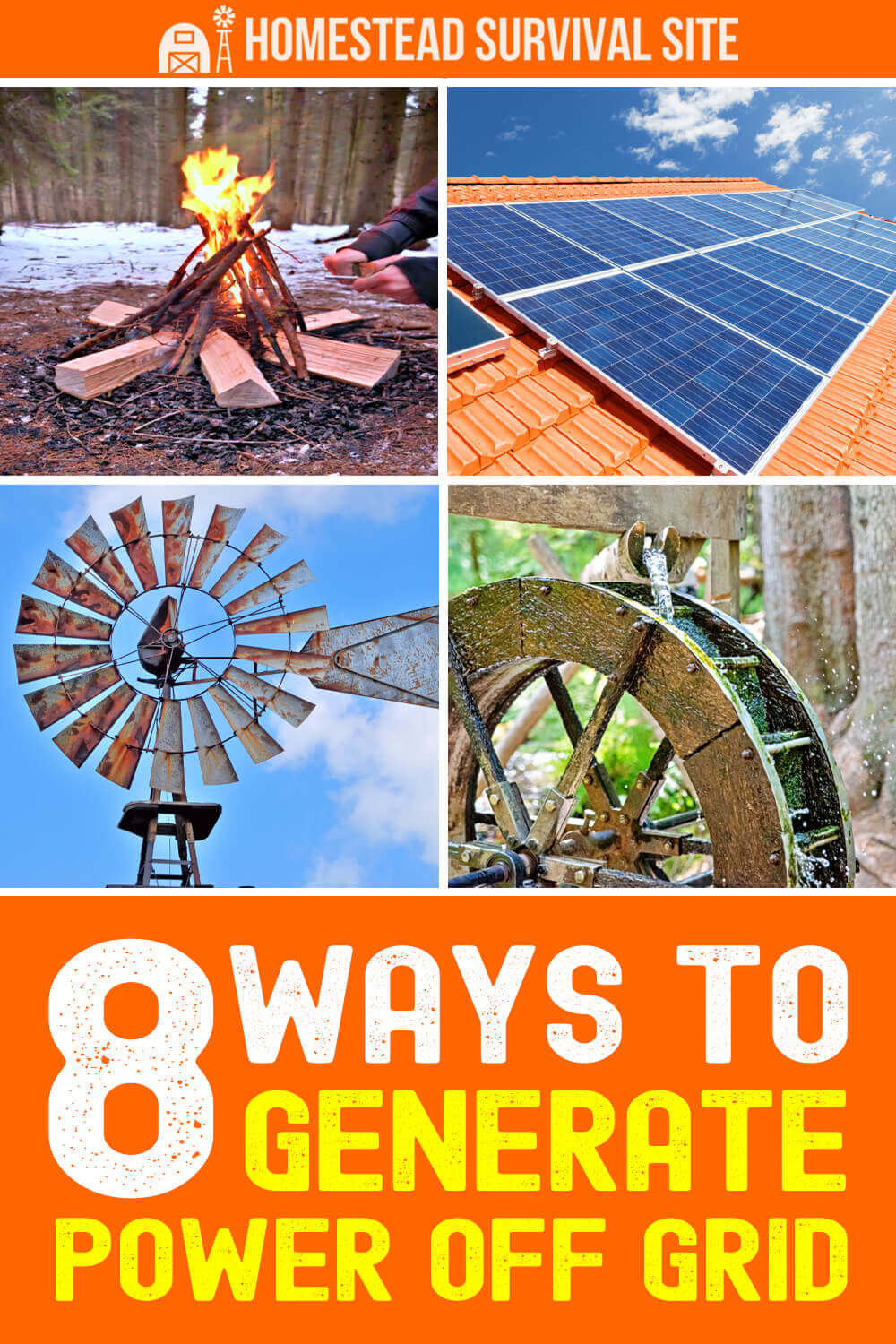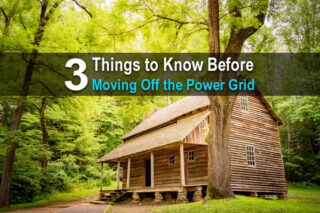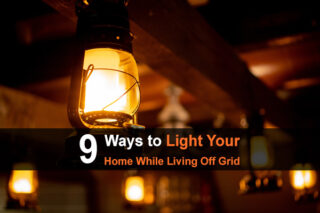Estimated reading time: 7 minutes
Although conserving energy is important to any homeowner, energy conservation takes on a whole new meaning when you live off the grid. Going off-grid means you need to generate and maintain your own energy sources. The benefits include saving money on utility bills, becoming more environmentally conscious, and enjoying the independence the lifestyle offers.
Before you go partially or fully off-grid, however, it is essential to know your options for generating your own electricity.
Want to save this post for later? Click Here to Pin It on Pinterest!
1. Solar Panels
Harnessing the sun’s rays is a popular and relatively easy way to generate your own electrical energy. Advances in solar technology have made photovoltaic panels flexible, transportable, and in some cases, even portable.
If you live in an area with abundant sunshine, solar panels can be a good option. You will need the panels, an inverter, and batteries. Depending on the type of panel you choose and how many appliances you want to run, a 2000 square foot home would need a solar array of about 4000 watts, which would require 12 to 18 solar panels.
After installation, the components of a solar system require little maintenance. However, the high cost of purchasing and installing a system big enough to power your entire home is still a big downside. Another con is that the system is dependent on sunshine, so you will not generate power at night or on cloudy days.
Here is a video that shows how to install your own solar system.
As you can see, it is not designed to be the home’s only power source but to provide emergency or temporary backup energy.
Here are some portable solar systems to consider. And here is an interesting video showing how you can charge your solar battery by pedaling a bicycle.
2. Windmills
Converting the wind into electrical energy is another way to generate power for your homestead. With wind turbines, you can harness clean energy 24 hours a day without dependence on sunlight. The first step to seeing if turbines are right for you is to find out the average wind speed in your area. You can calculate it yourself or contact your local weather service. Keep in mind that wind speeds can vary within a region depending on the topography.
You will want to install the turbines in a large land area that regularly receives a steady flow of wind. Windspeed is higher and more consistent at higher altitudes, so towers are needed to hold the blades up 100 feet or more. Since wind turbines have parts that move, they generally require more maintenance than solar panels.
A 400-watt turbine (which could power a couple of appliances) needs about a four-foot-diameter rotor. A 900-watt turbine requires a rotor of seven feet. A 10,000-watt turbine, which could generate enough power for a typical home, needs a turbine of 23-feet that would have to be mounted on a tower at least 100 feet tall. Obviously, this much space is not an option for many homeowners.
Here is a video demonstrating how to wire a tiny off-grid home with solar power and wind power.
3. Hydroelectric Power
If you have a source of running water on your property, hydroelectricity may be a good choice for your home. Micro hydroelectric power systems work in a similar way as turbines; they just use water current instead of wind to move the turbine.
An advantage of hydroelectric power is that the energy source (a river or a stream) is usually more consistent than either the sun or the wind. A disadvantage is the cost of installation and the very specific on-site conditions needed.
Here is a video showing how to install an off-grid micro hydro home system.
And here is a video that explains how to use a water wheel in a stream on your property.
And finally, here is a video that shows how to turn an old washing machine into a water-powered generator for an off-grid home.
4. Geothermal Power
Harnessing the heat from below the earth’s surface is an efficient way to extract renewable natural energy. With its numerous hot springs and volcanoes, Iceland gets one-fourth of its electricity from geothermal power. Other countries, including China, Sweden, and New Zealand, use geothermal heat and power, but it has been slow to catch on in the U.S.
Geothermal energy is quiet and clean. A downside is the current high-cost of a professional installation. In this video, a homeowner explains how he added a geothermal unit to his existing furnace.
5. Passive Living
A significant way to generate off-grid energy is through passive living. Designing your new home for energy efficiency or giving your existing home an energy upgrade can boost your energy levels by lowering your consumption.
With the right building materials, you can use your walls, floors, roof, windows, building exterior elements and landscaping to both heat and cool your home.
Simple aspects of passive design include protecting south-facing windows from the summer sun and then harnessing those same rays in the winter to heat your living space. Passive design also can include something as simple as changing the color of your roof to help cool or warm your home, depending on where you live.
Here is a video detailing the features of a passive energy home.
In this video, a Colorado homeowner demonstrates how he designed his passive house.
6. Fire
No, fire technically can’t create electricity. But it’s still a crucial source of energy, and if you live off the grid, you’re going to be quite dependent on it. After all, you can easily rely on fire for cooking and to stay warm (two things that we normally rely on power for).
While cooking with fire indoors may not be the brightest move, it’s a different story for outside. Simply having a fire pit alone means that you can cook a variety of meals, and furthermore, you can boil water and stay warm.
You may also be surprised at how effective a wood burning stove could be to help warm up your house, and it’s an easy alternative or substitute for an electric stovetop. You can further use your stove to help dry your clothes; just hang them up near the vicinity of the stove and wait a couple hours.
7. Well Water/Grey Water Systems
Like fire, well water technically isn’t a power system that generates electricity, but it can serve a variety of purposes that we normally use water for as well. If you’re truly living off the grid, you need to be disconnected from all sewage and water systems. Well water is beneficial because it allows you to have safe drinking water free of a municipal system.
Additionally, you can also rely on collecting your grey water (or the runoff water from sinks and showers) that can be repurposed for watering your gardens, cleaning purposes, or even used to help flush toilets.
8. Hybrid System
Last but not least, consider a hybrid system that combines solar and wind power together. This way, you will be better prepared for handling different weather fluctuations throughout the day. A hybrid system is ultimately more reliable than most solar or wind systems on their own.
It’s also worth noting that hybrid system are often much cheaper than the individual solar and wind systems on their own. This is because it needs less components for the wind and solar systems respectively, in comparison to if you were to rely on wind or solar exclusively.
As you investigate what will work for your off-grid home, you are likely to find that a combination of different energy supplies will be your best bet. The future looks bright for off-grid energy solutions. Innovations will continue to give us the ability to live with less dependence on traditional power systems.
Like this post? Don't forget to Pin It on Pinterest!
You May Also Like:












Tricia Drevets, thank you for this post. Its very inspiring.
Hi,
What about manual? You can use a bicycle to spin a generator. Granted it wouldn’t produce a lot of power, but it could give enough for lights or other small appliances. Otherwise a great article!
There are a few more you could use as well, for example bio-gas.
Wood burning stoves are great, as long as you keep the flue clean. Also, if your home is made of adobe, the warmth is kept inside very well. Adobe walls also keep the cold out. The best house I ever had was adobe as far as heating and cooling was concerned.
Yes, fire can generate electricity. There are thermo-electric generators. A small amount, but it does work. Many of those wood stoves prove the principal every day.
I was surprised magnetic and earth generators didn’t get a mention!
Tell me more about way’s to make electric 💡 please